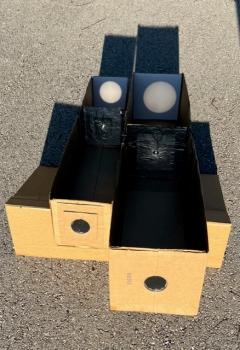
Safe Solar Viewer

- School:
- Alternative Schools
- Subject:
- Science
- Teacher:
- Richard (Bart) Thomas
- Students Impacted:
- 1000
- Grade:
- 9-12
- Date:
- July 19, 2023
Investor
Thank you to the following investor for funding this grant.
A Champion For Learning - $1,150.00
Original Grant Overview
Goal
There are two solar eclipses that could be seen this school year.
Teachers will build a 36" x 6" x 6" or a 42" x 8" x 8" Safe Solar Viewer out of a Uline box. An achromat lens set and a barlow lens will be the optics used in the box to produce a quality image of the sun. The image of the sun is seen on white cardstock inside the Uline box. This device is safe for viewing the sun since you are looking at the sun's image on a white screen.
What will be done with my students
When using the Safe Solar Viewer, students will be able to see a white image of the sun. The solar image produced will be 3.5 inches in diameter using the 36 inch box. A 5.75 inch diameter image of the sun will be seen when using the 42 inch box. Looking at the image of the sun on a white screen is totally safe.
Currently, the solar cycle is producing a large number of sunspots. Solar maximum is expected in the near future. Students can use the solar viewer to make measurements of sunspot positions in order to calculate the rotation rate of the sun.
The safe solar viewer will be particularly useful for students to observe the two solar eclipses in October 2023 and April 2024. This device will clearly show an enlarged image of the new moon coming in front of the sun during the solar eclipses, weather permitting.
Solar eclipses seen in the United States are very rare.
Benefits to my students
When students look at the sun through certified eclipse glasses, the sun is not magnified. Although the glasses are a great way to look at a solar eclipse, the image is quite small. When using the eclipse glasses, the color of the sun is orange.
The safe solar viewers (SSV's) magnify the sun's image using a combination of lenses. The solar image is much larger. It is easy to see sunspots in the white solar image of the SSV.
The SSV solar image can be seen by many students at once. This is an ideal scenario for educators. With a magnified image, sunspots can be seen. There are many things to discuss with students when viewing sunspots.
Students are quick to observe the movement of the solar image on the white screen. The image will move off the screen in 1-2 minutes. Students will realize that they have to keep adjusting the safe solar viewer to keep up with the rotation of the earth. Students will be able to quickly adjust the SSV.
The SSV makes it very easy for students to take photos of the sunspots and/or the solar eclipse progression.
The device can be used every school year and with the general public. This device will generate interest from
all ages.
Budget Narrative
The majority of the cost when building the safe solar viewers are the lenses. The objective lenses are achromats, a set of two lenses that help reduce chromatic aberration and produce a quality solar image in which you can see sunspots. The barlow lens is used to increase the diameter of the image.
The achromats are positioned in the front of the box are stationary. The barlow lens is movable. The solar image is focused by moving the barlow lens either toward of away from the objective lenses.
The hardboard is an essential part of the SSV. The hardboard is cut, then glued to the bottom of the box. The hardboard provides weight and stability to the solar viewer. Without the hardboard, the SSV would move or fall down in a slight wind.
The remaining items are used to complete the construction of the SSV.
There are enough supplies to make 40 SSV's.
Items
| # | Item | Cost |
|---|---|---|
| 1 | Objective Chromatic Lenses | $380.85 |
| 2 | Barlow lenses | $438.90 |
| 3 | X-acto knives with safety cap | $39.08 |
| 4 | Aluminum Foil | $9.59 |
| 5 | 110 lb cardstock | $12.04 |
| 6 | Double stick scotch tape | $14.96 |
| 7 | Titebond II Wood Glue | $35.11 |
| 8 | Medium Binder Clips | $21.39 |
| 9 | Hardboard | $90.28 |
| 10 | Jam Envelopes | $18.80 |
| 11 | Welding Lens #14 | $67.00 |
| 12 | Packaging Tape/Scotch Blue tape | $22.00 |
| Total: | $1,150.00 |



Share
Please share this page to help in fulfilling this grant.
Email to a Friend